Cobot | Discover collaborative robots as a new employee
- Details
- Hits: 13354
The entry of Cobots or collaborative robots into the production halls is in full swing. This revolutionary Robotic-Technology works hand in hand with people and optimizes work processes. Discover the exciting world of cobots and their diverse applications in industry and everyday life here.
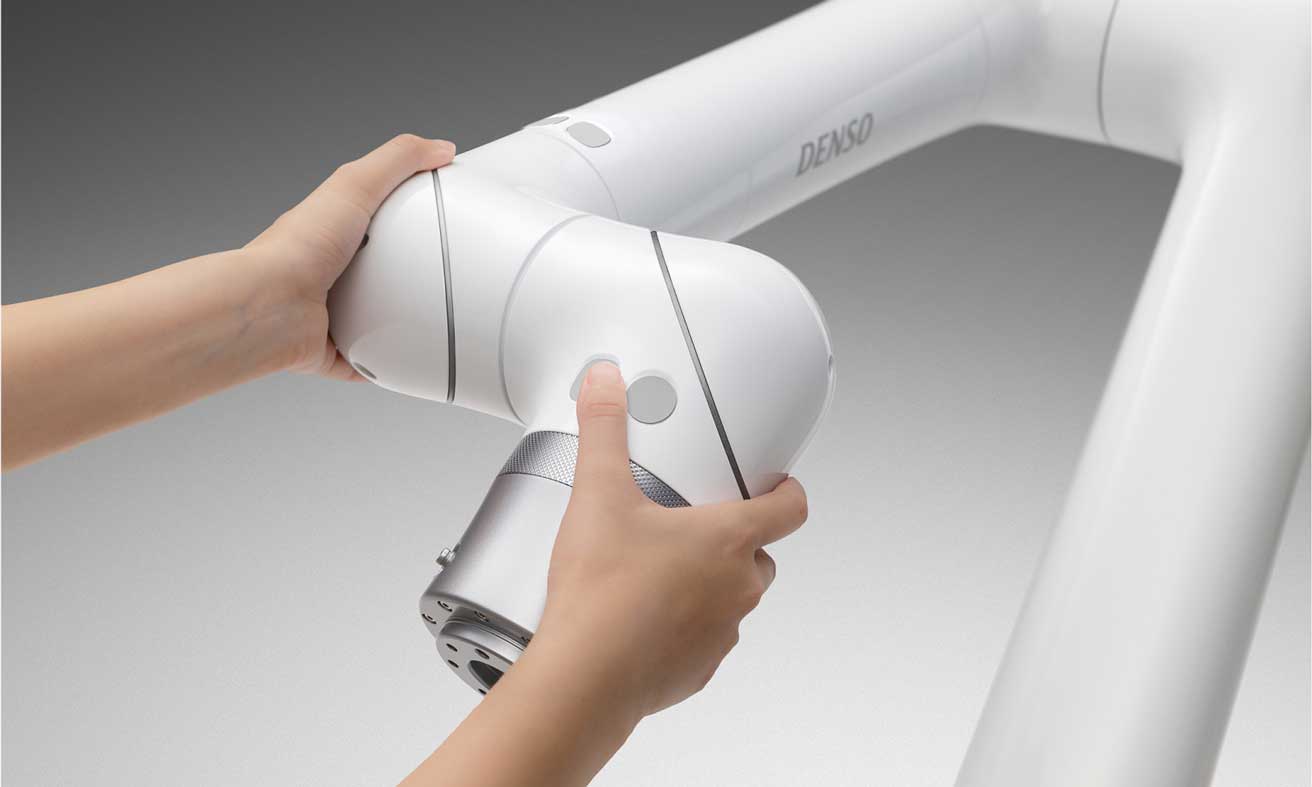
Contents
- Cobots in 2023 – The most important things in brief
- This is how you build a collaborative robot cell
- The right cobot for every production area
- Omron cobots with the fastest camera joint
- With ABB Cobot to the currently largest range
- Denso Cobot, as fast as an industrial robot
- Fanuc Cobots and why you should use themn
- Igus Cobot for collaborative service tasks
- Mitsubishi Cobot for high mix volume production
- Cobots to go from the plug-and-play construction kit
- Cobot Assista and its user-friendly features
- Linear axis extends UR Cobot reach
- Collaborative robot not just for making coffee
- Trends for cobots in packaging technology
- Manufacturer of cobots
- Brief overview of the development of cobots
- Explosive growth rate of cobots
- FAQ
Cobots in 2023 – The most important things in brief
With cobots you can get started with automation make it seamless or optimize existing processes. These collaborative robots are specifically designed to work alongside people and bring a level of flexibility that traditional industrial robots often lack.
Not only are they cost-effective and user-friendly in their own right Coding, rather also relieve employees from repetitive and tiring tasks. Their compact design and adaptive capabilities open up numerous new applications in manufacturing and other industries.
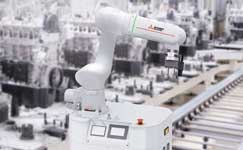 Reading tip: 5 reasons for cobots
Reading tip: 5 reasons for cobots
The still young technology of cobots is already permanently changing the way we work in applications such as packaging, palletizing, welding and assembly. More and more companies are turning to lightweight, easy-to-use robots to make their production more efficient. In addition to increasing Payload and Performance We will see more mobile and hybrid cobots in the future.
Cobot instead of industrial robots – is IR dying out?
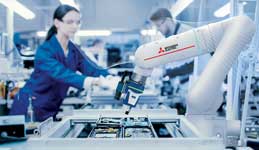 Will traditional industrial robots soon no longer be needed because the advantages of cobots make them superfluous? The answer, of course, is "no". If speed is required, it is still the first choice. However, the technology of cobots influences the development of industrial robots. Read here how the industrial robot specialist sees it:
Will traditional industrial robots soon no longer be needed because the advantages of cobots make them superfluous? The answer, of course, is "no". If speed is required, it is still the first choice. However, the technology of cobots influences the development of industrial robots. Read here how the industrial robot specialist sees it:
This is how you build a collaborative robot cell
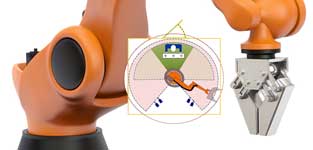 29.12.2023/XNUMX/XNUMX | Normative requirements have been created for safe collaboration between humans and robots. In many companies there are already collaborative robot cells in use. But what about that? Planning and construction of such robot cells? This post by Schmersal shows you the way.
29.12.2023/XNUMX/XNUMX | Normative requirements have been created for safe collaboration between humans and robots. In many companies there are already collaborative robot cells in use. But what about that? Planning and construction of such robot cells? This post by Schmersal shows you the way.
The right cobot for every production area
Below you will find new and further developments of collaborative robots for numerous industries and applications:
Omron cobots with the fastest camera joint
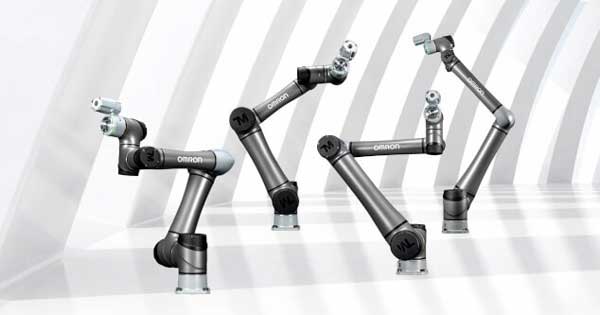 16.10.2023 | Omron presents new collaborative robots with the TM S series. These cobots were developed for many industries and company sizes. With new features, the new cobots can be introduced and used more easily and quickly than all previous models.
16.10.2023 | Omron presents new collaborative robots with the TM S series. These cobots were developed for many industries and company sizes. With new features, the new cobots can be introduced and used more easily and quickly than all previous models.
Four models with a payload of 5 to 14 kg and a range of 700 to 1.300 mm are available. Different types of assembly are possible, such as interaction with a mobile robot for a mobile manipulator solution (MoMa). Each robot has 6 swivel joints with repeatability ±0,03 mm and 6 degrees of freedom with an average speed of 1,1 to 1,4 m/s.
The models are available with and without integrated 1,2 M/5 M pixelColor cameras. For applications that require higher resolution, 2 GigE 2D cameras can optionally be used. The camera joint at the end of the robot arm is the fastest joint of its kind in the industry and four times faster than the previous model.
12 additional specific safety functions increase the total number to 31 and make these cobots safer than ever. In most cases there will be no external Safety control needed. The TM S Series meets ISO 13849-1 PLd Cat 3 and ISO 10218-1 safety standards and is UL/CSA/KC certified. Arm and control unit are designed in IP54. Use in clean rooms according to ISO 3 or under working scenarios with cutting oil is also possible.
Connection options include analog and digital signals, HDMI, Ethernet LAN, USB, RS232, Ethernet and Modbus TCP/RTU Master/Slave, with additional options for Profinet and Ethernet/IP.
With ABB Cobot to the currently largest range
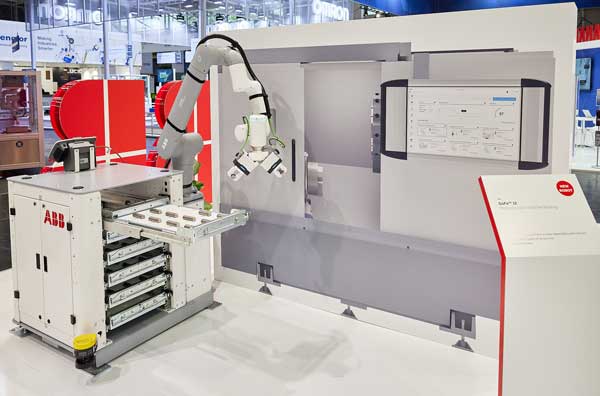 29.08.2023 | ABB shows on the EMO Solutions for flexible machine loading. These are suitable for the requirements of the metalworking industry for variant production with small volumes up to batch size 1.
29.08.2023 | ABB shows on the EMO Solutions for flexible machine loading. These are suitable for the requirements of the metalworking industry for variant production with small volumes up to batch size 1.
ABB cobots currently offer the greatest range in the cobot market gofa 10 and gofa 12 with a height of up to 1,62 m. They also have an increased load capacity and are suitable for polishing applications, machine loading or palletizing. The cobots can be programmed via “lead-through” programming and with the ABB “Wizard Easy Programming” software without having to write a program line.
ABB is presenting the Gofa 12 at EMO as part of a new solution for the collaborative machine tending in action. The user-friendly operation simplifies automation, especially for SMEs and first-time users.
Implementing machine tending is easy because all components are from a single source. Due to the slim design, the Cofa 12 is predestined for smaller and compact spaces in factory halls. An enclosure or security scanners are not required.
Denso Cobot, as fast as an industrial robot
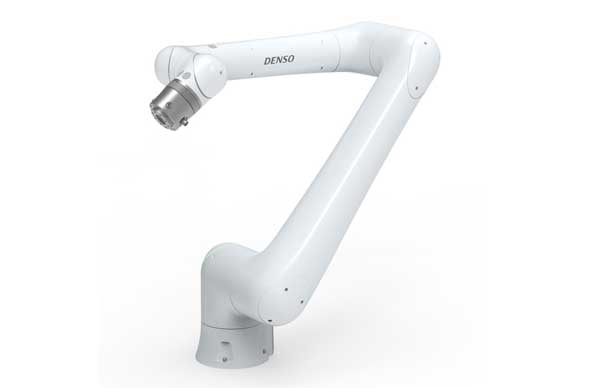 22.05.2023/900/1300 | The Cobotta PRO XNUMX and the Cobotta PRO XNUMX from Denso are currently the most powerful cobots on the market. Their payload is 6 or 12 kg, the manufacturer specifies the TCP speed as 2100 mm/s or 2500 mm/s and the repeat accuracy is impressive at ±0,03 mm or ±0,04 mm.
22.05.2023/900/1300 | The Cobotta PRO XNUMX and the Cobotta PRO XNUMX from Denso are currently the most powerful cobots on the market. Their payload is 6 or 12 kg, the manufacturer specifies the TCP speed as 2100 mm/s or 2500 mm/s and the repeat accuracy is impressive at ±0,03 mm or ±0,04 mm.
With this performance, industrial processes in the HRC segment become more efficient and productive. The series complements the first collaborative robot introduced in 2018 cobotta.
The compact, portable Cobotta PRO offers an inherently safe design and a wide range of functional safety. Become continuous torque and speed of all axes sensor-based monitored. The working speed can be adjusted to the level of via security scanners Industrial robotsincrease n.
If a person approaches the cobot, the speed is reduced so that they are not endangered. A touch-sensitive protective cover with integrated, highly sensitive sensors allows the speed in human-robot collaboration to be increased even further. The cobot can be seen on the Automatica be 2023.
Fanuc Cobots and why you should use them
28.03.2022 | fanuc presents the new Cobot CRX series, with which smaller companies and workshops can also get into robotics. Of course, these cobots are also suitable for medium-sized companies and production giants to simplify processes.
Igus Cobot for collaborative service tasks
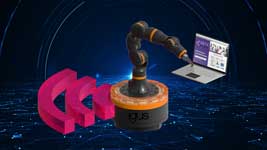 16.03.2022 | Igus delivers from now on Service robot Rebel also available as a smart version. The use of plastic makes the collaborative robots the lightest service at 8,2 kgrobot with cobot function in its class. The payload of the cobot is 2 kg and its reach is 664 mm.
16.03.2022 | Igus delivers from now on Service robot Rebel also available as a smart version. The use of plastic makes the collaborative robots the lightest service at 8,2 kgrobot with cobot function in its class. The payload of the cobot is 2 kg and its reach is 664 mm.
Mitsubishi Cobot for high mix volume production
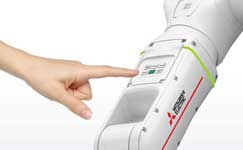 11.08.2021/XNUMX/XNUMX | The desired reduction in lot sizes to one has the High mix low volume (HMLV) production result. Collaborative robots or cobots help to efficiently meet such individual requirements in smaller batches. Mitsubishi Electric offers the cobot Melfa Assista for this purpose.
11.08.2021/XNUMX/XNUMX | The desired reduction in lot sizes to one has the High mix low volume (HMLV) production result. Collaborative robots or cobots help to efficiently meet such individual requirements in smaller batches. Mitsubishi Electric offers the cobot Melfa Assista for this purpose.
Cobots to go from the plug-and-play modular system
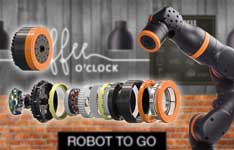 18.02.2021 | "With our low-cost automation solutions, we enable designers to enter the future of service robotics at low cost," explains Stefan Niermann, Igus Management for low-cost automation. "This opens up space for completely new ideas - and all made in Germany".
18.02.2021 | "With our low-cost automation solutions, we enable designers to enter the future of service robotics at low cost," explains Stefan Niermann, Igus Management for low-cost automation. "This opens up space for completely new ideas - and all made in Germany".
Cobot Assista and its user-friendly features
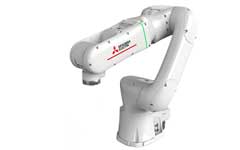 23.06.2020/XNUMX/XNUMX | The Cobot Assista from Mitsubishi Electric is used to provide precise and safe support for people in production. The collaborative Melfa robot was created for the Automation at the side of human operators without necessary protective device or security fence.
23.06.2020/XNUMX/XNUMX | The Cobot Assista from Mitsubishi Electric is used to provide precise and safe support for people in production. The collaborative Melfa robot was created for the Automation at the side of human operators without necessary protective device or security fence.
Linear axis extends UR Cobot reach
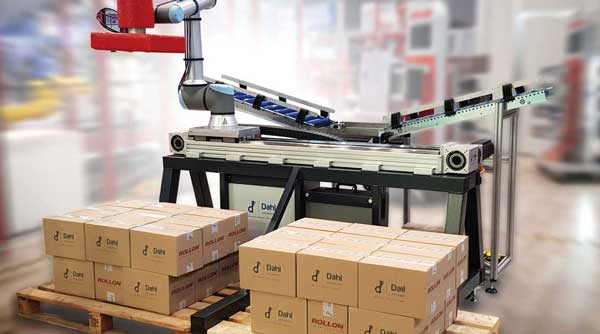 February 17.02.2020, XNUMX | The cobot from Universal robots (UR) has a significantly greater range. This was made possible through the use of UR + certified Linear axis with motor from Rollon.
February 17.02.2020, XNUMX | The cobot from Universal robots (UR) has a significantly greater range. This was made possible through the use of UR + certified Linear axis with motor from Rollon.
They are ideal for working with the popular collaborative robots or cobots in the Automation designed. This is the all-in-one package Dahl linear move fully integrated into Universal Robots system. The drive can be individually configured and very easy to operate.
Dahl Automation and Rollon take the popular cobot from Universal Robots to a new robot level with this simple plug-and-play solution. The certified linear unit Robot series is closed, while the linear unit R-Smart series was designed to be open.
Both linear axes are very rigid and offer a high load capacity, torque control, traversing speed and positioning accuracy. Rollon has precisely matched the size and performance of the linear units to the different cobots from Universal Robots.
Put cobots into operation intuitively
As part of the all-in-one package Dahl Linear Move, the Rollon axis consists of a configurable linear axis with motor, gear, limit switch and mounting kit, an electronic switch cabinet as well as the software component URCap. Commissioning and operation are very easy.
The user can use them without complex axis design, adjustment and Coding build and connect. The UR interface "URCap" is intuitive and guides the user step by step through the installation. The user does not need any special programming knowledge for the robotics commissioning. He can also make changes to the production layout quickly and easily according to the application.
Precisely fitting linear axis of collaborative robots
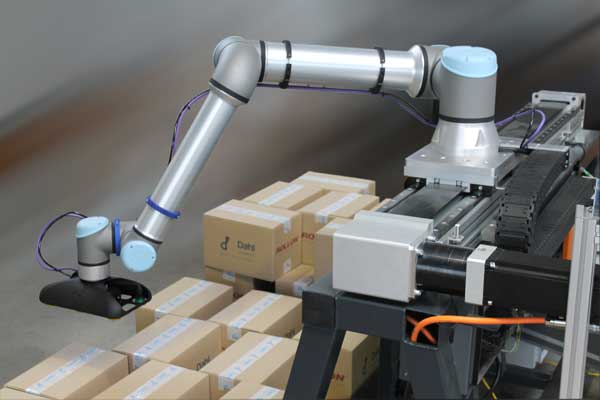 Rollons UR + certified axis is based on a robust structure made of extruded, anodized aluminum profile with a square cross-section. The driving force is reinforced by a steel Timing belts transferred from polyurethane.
Rollons UR + certified axis is based on a robust structure made of extruded, anodized aluminum profile with a square cross-section. The driving force is reinforced by a steel Timing belts transferred from polyurethane.
The cobot moves on two parallel paths Profile rail guides with a total of four carriages. the linear guide supports the loads and moments that occur. The ball-guided linear units allow a high load capacity and load. Their operation is low-maintenance, the noise level is low and the service life is long.
The linear axis with motor can custom adapt to the respective Cobot application. By extending the basic version by 1 m, the user gets exactly the range he needs for his application in 100 mm increments. Speeds of up to 4 m/s or 5 m/s and accelerations of up to 50 m/s2 ensure the dynamics. The repeatability is ±0,05 mm.
Plug-and-play linear axis for cobots
The UR + certified linear axis with motor is not only suitable for applications in the Intralogistik. UR robots with linear axes can also be used efficiently and flexibly in handling, drive technology, automation, palletizing, machine assembly, or for the collaborative workplace.
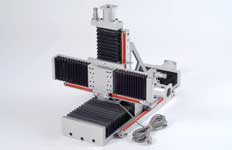 Linear unit with spindle guide as standard and special solution
Linear unit with spindle guide as standard and special solution
Dahl linear move is the result of the successful cooperation between Rollon and Dahl Automation, the first contractual partner of Universal Robots in Germany. The plug-and-play solution is collaborative with the robots E-Series Polyscope version 5.1 or higher compatible. You can find the robots on the worldwide UR + platform by UR.
Collaborative robot not just for making coffee
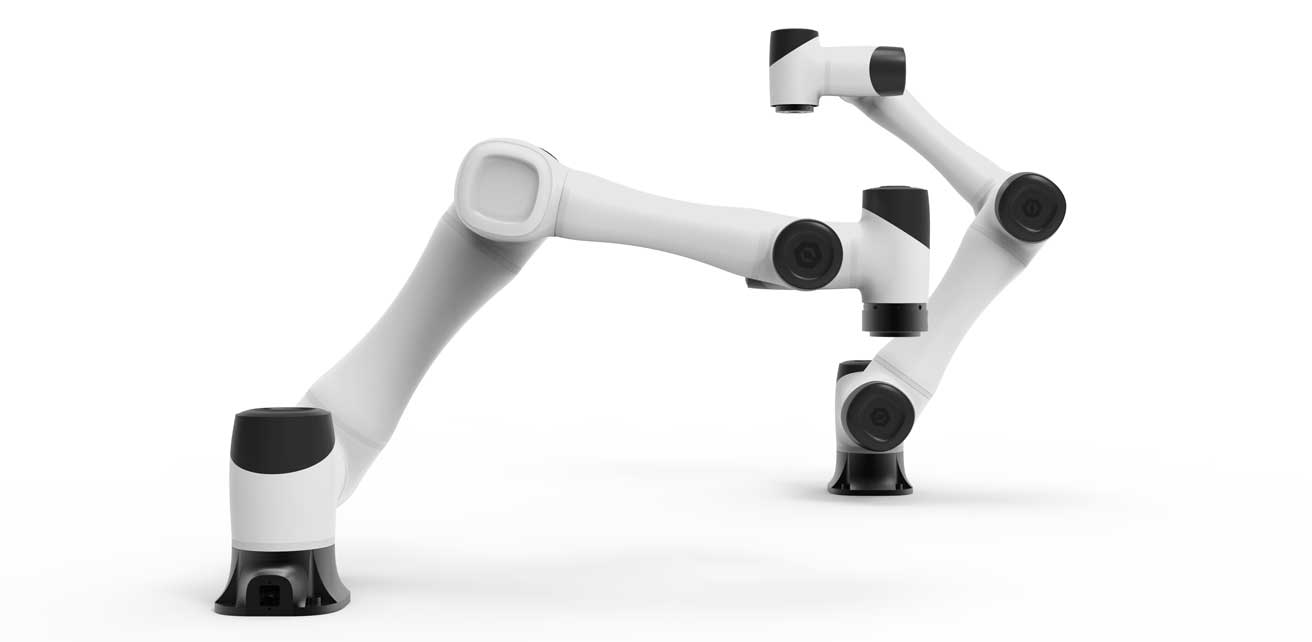
27.03.2019 | Dobot showcases its eponymous CR6-6 5-axis collaborative robotic arm in demos including pick and place, sorting, and motion tracking. He's the second Robotic arm in the collaborative Dobot robot series and offers a variety of possible uses in small and medium-sized companies as well as in educational institutions.
Regardless of whether free and flexible movements or predefined sequences – the Robotic arm can be used for different applications thanks to its compatible design. Through various adaptive grab it can pick up and handle a variety of objects and shapes. Its high-precision linear movements make it versatile, from making coffee to working in a laboratory. The CR6-5 is ideal for working with people and does not pose any danger to the user even in the event of a collision.
Embeddable Google Image and Speech Recognition is powered by Google TPU2 and TensorFlow chips for feature extraction, pattern matching and AI-related applications.
Trends for cobots in packaging technology
 The packaging industry is also adapting under the influence of global influencing factors such as regulation, a shortage of skilled workers and digital transformation the changing market requirements. The industry is increasingly relying on solutions such as cobots, KI and intense Data processing. Malte Schlüter from Mitsubishi Electric reveals where the industry will develop.
The packaging industry is also adapting under the influence of global influencing factors such as regulation, a shortage of skilled workers and digital transformation the changing market requirements. The industry is increasingly relying on solutions such as cobots, KI and intense Data processing. Malte Schlüter from Mitsubishi Electric reveals where the industry will develop.
Manufacturer of cobots
There are numerous cobot manufacturers, each with their own strengths and specializations. The following cobot manufacturers offer a wide range of collaborative robotics for a variety of applications:
- ABB is particularly known for the use of its cobots in the automotive industry for quality assurance. The company offers a diverse range of collaborative robots that can quickly adapt to environmental changes.
- Aubo is a leading cobot manufacturer distinguished by its open source-based, precision-calibrated and easy-to-use collaborative robots that can respond flexibly to new processes.
- Automata's industrial robot arm EVA was designed specifically for laboratory automation. The Kassow Robot is easy to use, compact and, with 6 degrees of freedom, enables machine operation, product testing and inspections.
- Bosch Rexroth has pushed the development of 7-axis cobots that are very flexible and can be easily repositioned depending on production needs. The focus of Kassow Robots is on payloads of 5 to 18 kg.
- Comau offers mobile and collaborative robots such as the Racer-5 Cobot, which can automatically switch from collaborative to non-collaborative mode, or the Aura Cobot with the largest payload on the market of up to 170 kg.
- Denso, is through the development of the fast, productive and safe Cobotta and Cobotta PRO able to automate manual-intensive tasks.
- Doosan offers cobots with highly sensitive torque sensors from the M, H and A series. They recognize obstacles in the work environment and can therefore carry out complex tasks in the smart factory.
- Epson has an extensive range of Scara robots and is a world leader in the production of this type of robot. We also offer compact, powerful 6-axis robots that are known for their flexibility and reliability.
- fanuc offers various Cobot series that can be used to automate entire assembly lines. Additionally, a Fanuc Cobot is an ideal solution for manufacturers with little or no robotics experience.
- Igus developed the RebeL, a cobot made of high-performance plastic that is cost-effective and lightweight. This cobot offers 6 degrees of freedom, a payload of 2 kg and a reach of 664 mm. In addition, Igus has the RBTX Marketplace created that brings together providers and users of robotics and offers simple and cost-effective solutions
- Kuka did pioneering work in the development of the world's first sensitive lightweight robot LBR iiwa. In addition, Kuka Cobots are known to support and relieve human operators in production and are even used in medical applications.
- Mitsubishi Robotics developed the Melfa Assista Cobot, which can operate alongside humans and is known for its high speed. The cobots are also known for their slim and compact design, which offers high usability at low cost.
- Omron offers cobots for repetitive processes such as loading and unloading, machine assembly or assembly. They can be used flexibly and, according to the manufacturer, should offer the highest return and enable quick entry.
- dusty produces 4- and 6-axis industrial robots, cobots, mobile robot systems and automated guidance vehicles. The cobots are based on the proven TX2 industrial robot and offer fast response times and embedded modular safety.
- Universal robots is one of the leading cobot manufacturers and is considered a pioneer of cobot technology. The purchase of new cobots usually pays for itself within a year.
- Yaskawa In addition to industrial robots, manufactures collaborative robots that are powerful, versatile and easy to use. The manufacturer also works with various end-of-arm tooling manufacturers and has introduced the Smart Series for collaborative robots, which includes everything necessary for using a collaborative robot.
Brief overview of the development of cobots
Cobots have a relatively young history and have only just reached their “roaring twenties”. They were invented by J. Edward Colgate and Michael Peshkin, both professors at Northwestern University, USA. Their 1997 US patent describes cobots as “a device and method for physical interaction between humans and a general-purpose computer-controlled manipulator.” The development was initiated by General Motors in 1994 under the leadership of Prasad Akella. A way should be found to make robots or robot-like devices safe enough to work with humans. The company Universal Robotics is considered a pioneer, having sold the world's first collaborative robot or cobot in 2008. Even though it wasn't that long ago, it was long before the term for this emerging type of robot was on everyone's lips.
The development at a glance:
- Late 1990s: Danish engineer Dr. Esben Østergaard develops the first cobot UR5 during his doctoral thesis.
- 1997: US patent by J. Edward Colgate and Michael Peshkin
- 2008: Founding of Universal Robots in Denmark, start of sales of the UR5
- 2010: First ISO standard for cobots with guidelines for safe collaborative operations with humans.
- 2012: Founded Rethink Robotics in the US, introducing the Baxter cobot for use in manufacturing
- 2014: ABB introduces the Yummi cobot for collaborating with humans in small parts assembly
- 2015: Kuka launches the LBR Iiwa Cobot for use in many industries such as aerospace, aerospace, automotive and medical.
- 2017: The global cobot market hits the $200 million mark.
- 2018: Cobots worldwide hit $500 million.
- 2021: The global market for cobots is estimated to be $2030 billion by 8
- 2022: The global cobot market reaches the 1,1 bn. US dollar sales. The global market for cobots is projected to reach US$2028 billion by 9,2 at a CAGR of 41,5%
Sources for numbers: Berkshire Hathaway, Elektromate
Explosive growth rate of cobots
Cobots, or collaborative robots, have received significant attention in recent years. They are designed to work alongside humans and complete tasks that require human-like skills. According to the Research and Markets report, the global cobot market is expected to grow from $710 million since 2018 to $12,3 billion by 2025. This would correspond to an annual growth rate of 50,1%. Another statistic is that cobots accounted for about 2021% of all industrial robots sold in 5. Due to the wide range of possible applications in a wide range of industries, from the automotive industry to medical technology, we can expect that cobots will achieve an even larger market share in the near future.
FAQ
- What do you mean by cobots?
- What is a collaborative robot?
- Which cobots are there?
- Where are cobots used?
- How much does a cobot cost?
- What can a cobot do?
- How fast is a cobot?
- Are cobots industrial robots?
What do you mean by cobots?
A cobot is a collaborative robot specifically designed to interact directly with people in a shared workspace. In contrast to conventional industrial robots, which often work in isolation, cobots with Sensors equipped to detect human movements and react safely. They support workers with repetitive or ergonomically challenging tasks.
What is a collaborative robot?
A collaborative robot, often called a cobot, is a robot designed for direct interaction and Collaboration with people is designed in a shared workspace without requiring separate protective measures.
Where are cobots used?
Cobots or collaborative robots are in one multitude used by industries. They support in the Automotive industry, in the assembly of small parts, in electronics manufacturing and in healthcare. Thanks to their flexibility and safety functions, they are also increasingly in demand in smaller production environments and specialized areas such as quality control or packaging.
Which cobots are there?
Cobots can be divided into different types according to their functionality and design:
- Cartesian Cobots are based on a Cartesian coordinate system and move linearly along the X, Y and Z axes.
- Scale Cobots specialize in pick-and-place tasks, typically in horizontal planes.
- 6-axleSome cobots offer six degrees of freedom and are very flexible in their movements and applications.
- Delta Cobots are known for their high speed and precision, especially in packaging applications.
- Parallel Cobots use multiple parallel arms to move an object and offer high load capacity.
How much does a cobot cost?
The costs for a cobot vary depending on the model, functionality and manufacturer, but are often in the range of 20.000 to 60.000 euros. A cobot starts at Igus Rebel Starting from 4970 €.
What can a cobot do?
A cobot or collaborative robot can work alongside people, take on tasks such as lifting, sorting or assembling and can be programmed or Things to Learn adapt to different applications.
How fast is a cobot?
The speed of a cobot depends on the model and application, but for the safety of human collaboration they are typically limited to speeds that avoid injury. One of the fastest cobots currently available is up to 2500 mm / s a Cobotta Pro by Denso.
Are cobots industrial robots?
Essentially: Ja. Although they are often compared to one another, cobots are a subgroup of industrial robots that are specifically designed to work directly with people in a production environment.
Source: This article is based on information from the following companies: ABB, Denso, Dobot, Igus, Mitsubishi Electric, Rollon.

Angela Struck is editor-in-chief of the development scout and freelance journalist as well as managing director of Presse Service Büro GbR in Ried.
